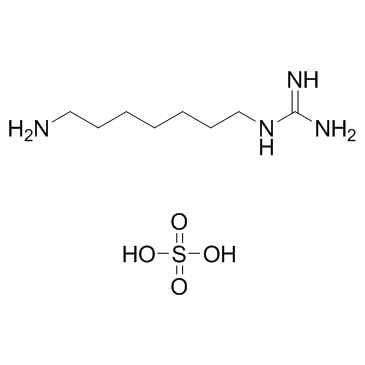GC7 Sulfate
Modify Date: 2025-08-21 06:24:35

GC7 Sulfate structure
|
Common Name | GC7 Sulfate | ||
|---|---|---|---|---|
| CAS Number | 150417-90-6 | Molecular Weight | 270.35 | |
| Density | N/A | Boiling Point | N/A | |
| Molecular Formula | C8H22N4O4S | Melting Point | N/A | |
| MSDS | N/A | Flash Point | N/A | |
Use of GC7 SulfateGC7 Sulfate is a deoxyhypusine synthase (DHPS) inhibitor. |
| Name | GC7 Sulfate |
|---|
| Description | GC7 Sulfate is a deoxyhypusine synthase (DHPS) inhibitor. |
|---|---|
| Related Catalog | |
| Target |
DHPS[1] |
| In Vitro | The treatment of MYCN2 (±Dox) and BE(2)-C cells with GC7 Sulfate for 72 h at various concentrations (0.1 to 100 μM) significantly reduces the number of viable cells in a dose-dependent manner. In MYCN2 cells, 5 μM of GC7 Sulfate inhibits cell viability by ~40 and ~60 %, respectively, compare to untreated control cells. BE(2)-C cells require 25 μM of GC7 Sulfate to reduce cell viability by ~50 %. Exposure to 10 and 100 μM GC7 for 72 h clearly decreases the levels of total retinoblastoma (Rb) and phosphorylated Rb as well as of Cdk4 protein, and increases the levels of p21 protein[1]. Between 0 and 20 μM, GC7 Sulfate induces little cytotoxicity in HCC cells, while higher concentrations of GC7 Sulfate (50 to 100 μM) significantly inhibit the viability of all five HCC cell lines tested. Newly synthesized 3H-labeled hypusine of eIF5A1/eIF5A2 is rarely detected after 20 μM GC7 Sulfate treatment, compare to untreated control. The activity of [3H]-spermidine incorporated into HCC cells is significantly decreased by 20 μM GC7 Sulfate or higher concentration[2]. |
| Cell Assay | Cell viability is analyzed with the MTS assay kit in accordance with the manufacturer’s protocols. Briefly, after treatment with GC7 Sulfate for 72 h at various concentrations (0.1 to 100 μM) in 96-well plates, cells are directly incubated with the MTS dye reagent for 1 h at 37°C in a 5 % CO2 atmosphere. The absorbance is read at 490 nm using a reader[1]. |
| References |
| Molecular Formula | C8H22N4O4S |
|---|---|
| Molecular Weight | 270.35 |
| Storage condition | 2-8℃ |